We get two legends together for this extraordinary interview about an extraordinary book, Aotearoa: The New Zealand Story. Donovan Bixley interviews Gavin Bishop.
Rain is hammering the roof of my studio in Taupō, so my ears are squinting to hear Gavin Bishop’s sonorous voice coming down the line, from his studio in Christchurch. We yabber away for an hour, me highly excitable and never finishing my sentences, and Gavin deep and thoughtful, with his wacky humour bubbling just under the surface. Our rambling conversation travelled down roads of national significance, into social media, and, somewhere along the way, we discussed Gavin’s sumptuous new book, Aotearoa.
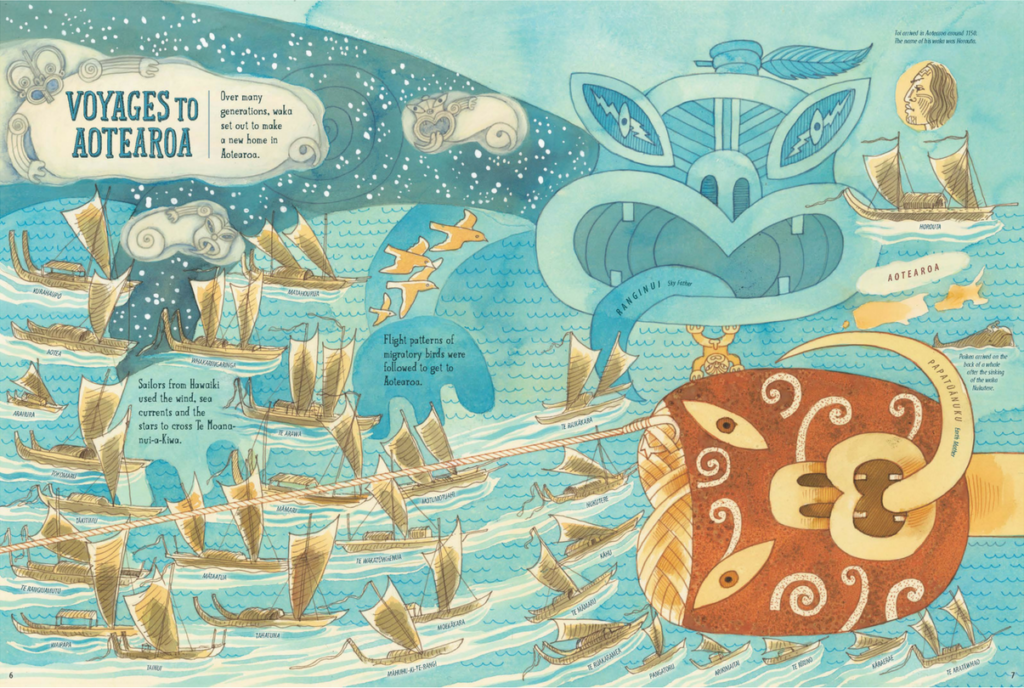
The book opens like a well-edited movie title, with Gavin’s illustrations taking us through a hundred million years of prehistory – and that’s just in the end papers and contents – before we’re thrust into the swirling history of Aotearoa New Zealand.
Like all great picture books, it’s a book for adults too. A book to be read with tamariki. It’s a work of tremendous research and wisdom. I ask Gavin if he could have done a book like this earlier in his career?
Like all great picture books, it’s a book for adults too. A book to be read with tamariki. It’s a work of tremendous research and wisdom
‘It would have been a lot different. I’ve gone back and dipped into 70 years of life.’
And dip is a perfect description of the type of book Aotearoa is. Gavin says, ‘The book actually does remind me of one of those things I had as a kid – big annuals, called Big Dippers, because you could just open them anywhere and dip into the book on that page. The story and the puzzles were all complete on those two pages facing each other.’
This is exactly the type of book I love too. Huge illustrations drawing you in, and a very economic use of text to ask questions and state the facts. It moves quickly from Gondwanaland onto the Voyages to Aotearoa, and I love the way Gavin has made Māori such an integral part of the entire book. Māori publishing can often be marginalised into its own category.
‘I personally think that all of our history belongs to all of us. We don’t say ‘we’re Māori, and therefore this is our history’, or ‘we’re Pākehā, and this is our history.’ We live here. This is our history, this is the history of our country, and I really want kids to think that.’
‘This is our history, this is the history of our country, and I really want kids to think that.’
And it’s wonderful to see this stated aloud in the full glory of a big commercial production like Aotearoa.
Genesis and genealogy
Aotearoa was initially conceived by publishers Penguin Random House, as a kind of large format map book for kids. As a lover of maps, Gavin leapt at the chance. However, the direction of the project was not fully set when senior editor, Catherine O’Loughlin went on maternity leave. Thanks to this, with deadlines looming, Gavin played a bigger part in forming the book than most commissioned writers, sailing the project off into uncharted territory – producing an expansive, and yet very personal, illustrated history of New Zealand.
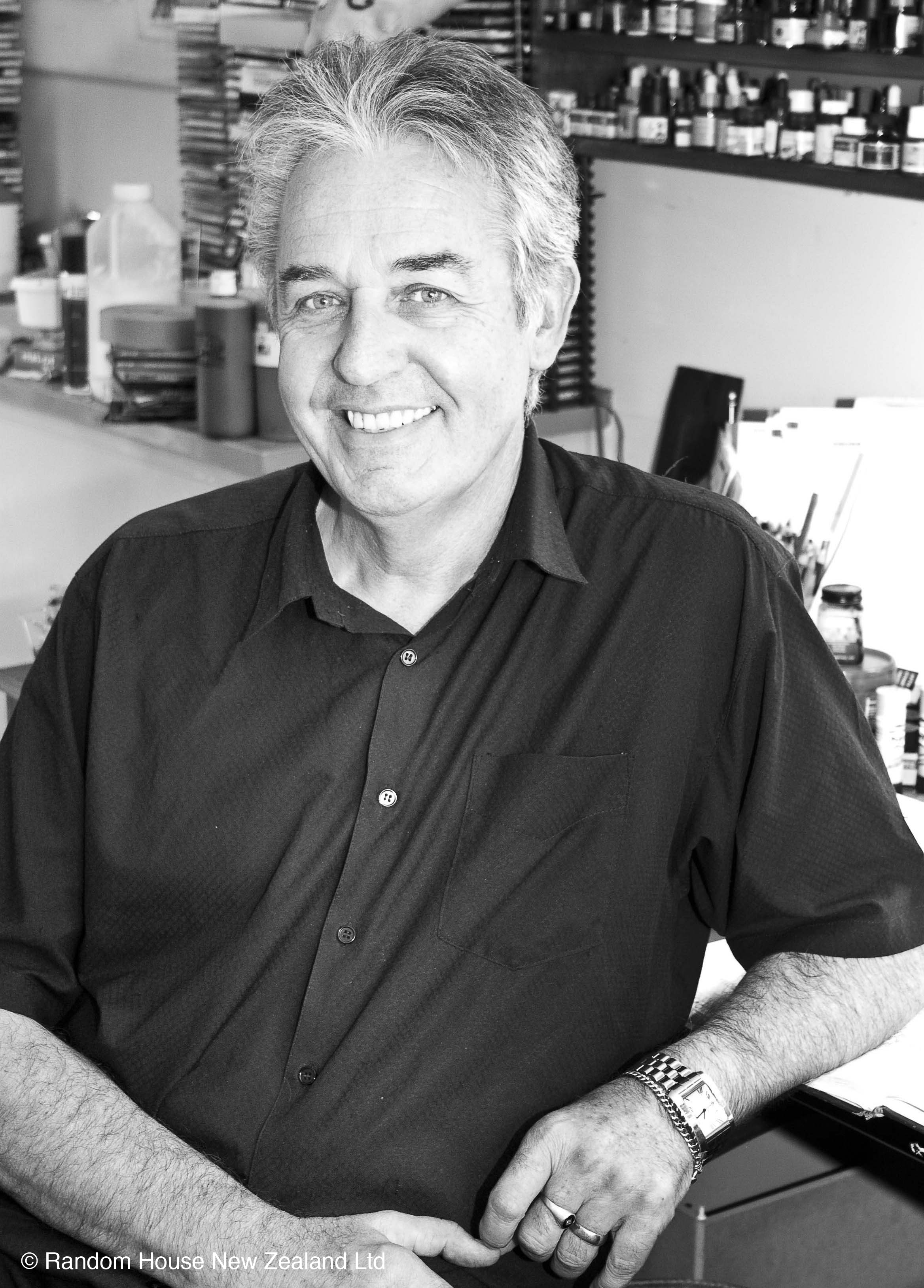
‘I’ve included all sorts of things that are personal, like my family. There’s mum and dad on their honeymoon, and me with my Grandma in Invercargill.’
Another of Gavin’s ancestors, Te Wairua O Hinepau, the spirit of Hinepau, supervises our nation’s progress on each spread. I like to think she’s also looking down over Gavin’s life, career and family as they pop up throughout New Zealand’s history.
‘Māori people, in particular, hold on to all those ancestral things. And they talk about them as if they’re still around, they feel as if they’re actually part of them.’
‘There’s a terrific Māori saying, ka mua, ka muri, which translates, ‘we walk into the future backwards’,’ says Gavin. That concept is taken through to Aotearoa’s layouts. The past, the present and the future are one, not a chronological constraint that must run from top to bottom, left to right in each illustration.
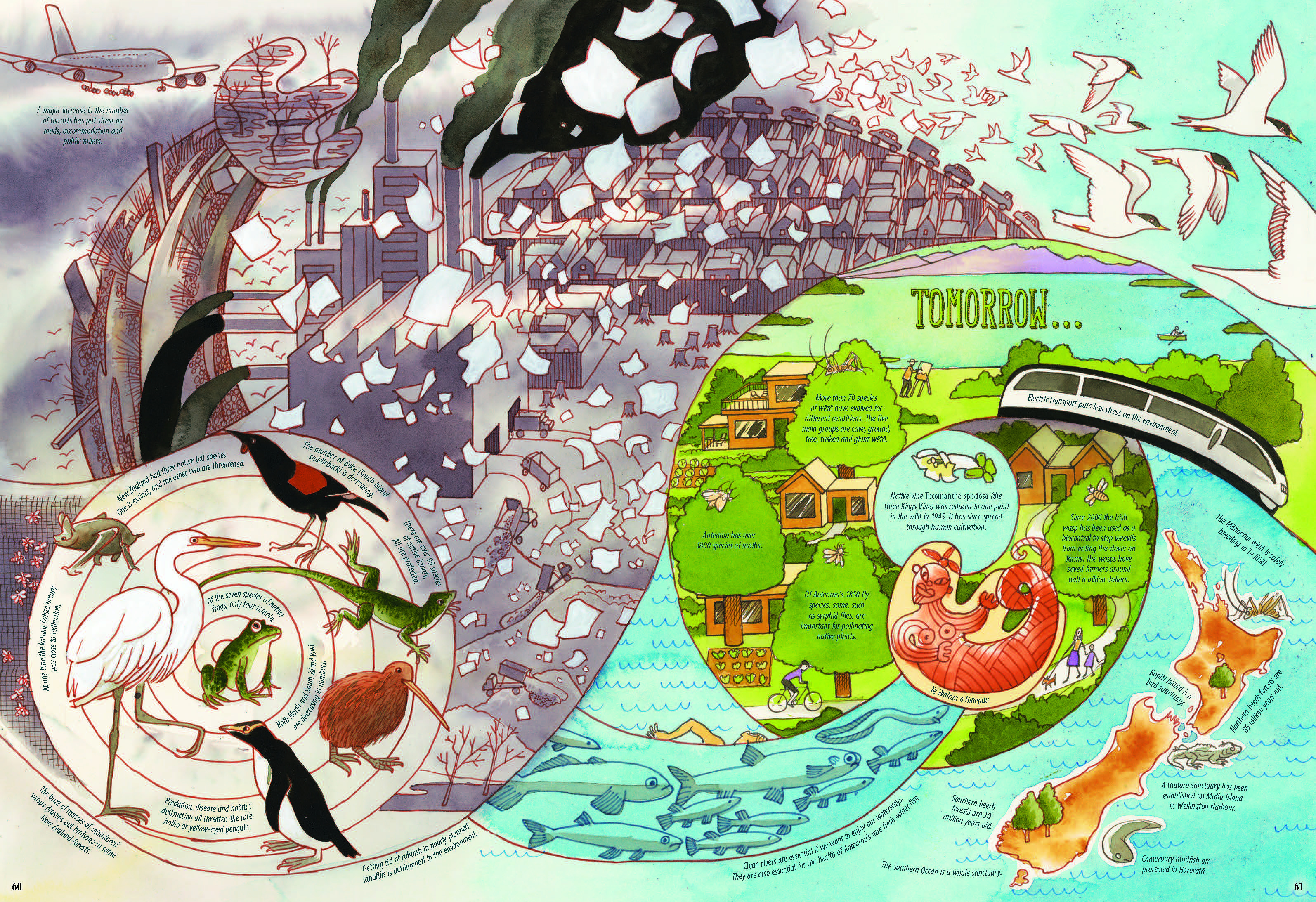
Great swirling compositions flow throughout the book, taking the form of Papatūānuku – the Earth mother. I mention that Gavin’s layouts remind me of wordless books, and we go off on a wild tangent about graphic novels and how text and timelines dominate the pictures, so that the reader races on to the next scene. In Aotearoa, thanks to the loose narrative style, we are allowed to drift around and take in whatever we want at our own leisure.
All this cavorting composition of history does actually flow in a general chronology. ‘World War 2 does follow World War 1,’ Gavin laughs under his breath. But amongst it all, he homes in on some specific aspects of our history and culture. ‘Every now and then, there’s, what I call, a Survey Page, like employment, or housing and homelessness.’
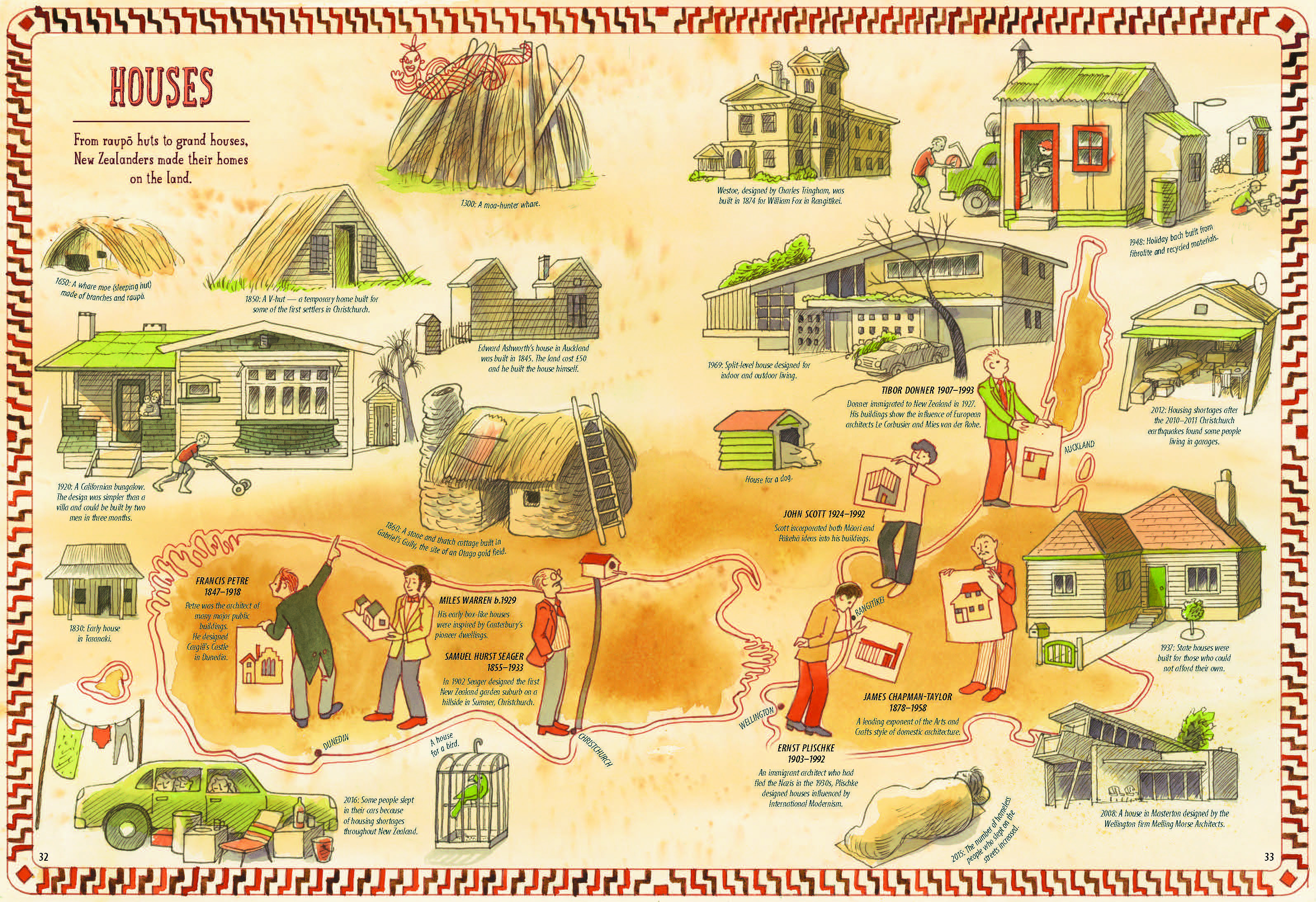
The joys of Maximalism
I tell Gavin I’m a fan of Maximalism — or whatever the opposite of Minimalism might be called?
‘I am too actually….’ he enthuses. ‘I like to have enough stuff in a book that you can go back and read it again and again.’
‘It should have layers of story and meaning that you find as you re–read it and revisit it.’
Gavin draws on the type of busy images he liked as a boy.’There are lots of little things in the book that kids will pick up.
‘You can never know what will spark a child’s interest, and Aotearoa’s busy pages encourage self-instigated discovery. Scratch the surface, ask a question and soon you’ve got a whole new obsession. One illustration sports an ugly pixie head.
‘You can never know what will spark a child’s interest, and Aotearoa’s busy pages encourage self-instigated discovery.’
‘I’ve picked up things that I found fascinating as a child, like Pixie Towns.’
‘They first started in Nelson, in 1933, and then they travelled around the country. They became so popular that there were lots and lots of them, and they would appear in the school holidays in department stores.’
‘I used to stand, by the hour, looking at these strange, ugly, mechanical puppets, that were driven by big loud machines that sort of drowned out everything else in the room.’
‘I used to get so lost in it, in my mind.’
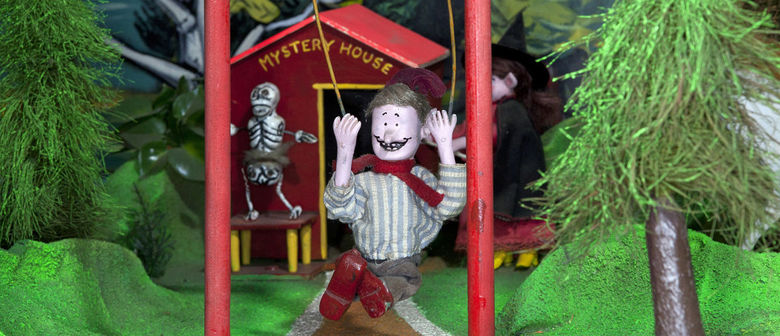
It’s a perfect metaphor, for the way picture books can also take kids away into their own worlds of imagination. Pixie Town is also an example of the hidden history waiting to be discovered behind each quirky little snippet in Gavin’s illustrations.
And quirky they can be. Gavin’s sense of humour comes through on the spread dedicated to fashion. Witness the very specific clothing of a maths teacher from 1972. On another page, amongst international sporting gods, Richie McCaw and Sir Ed, is the not-quite-so-world-famous, Chris Plank of the Warkworth Croquet Club. ‘I hope Chris sees himself in my book,’ chuckles Gavin. Elsewhere, pioneering drag queen, Carmen sits next to adversary and lobbyist, Patricia Bartlett, ensuring lots of discoveries for adults within Aotearoa’s oversized pages too.
Foolscap thumbnails
With such a large format, and detailed illustrations, Gavin couldn’t do thumbnail storyboard roughs, the way you’d normally map out a picture book. ‘I had to do these big foolscap drawings,’ says Gavin, of the 65 pages – twice the length and twice the dimension of a normal picture book. Ever impending deadlines meant Gavin had to illustrate sections and send them off to the publisher in batches of five double page spreads.
‘Those five spreads — I couldn’t redo those, they were gone. So then I started the next lot and I was really quite anxious that the pictures would change between each lot of five. I was absolutely paranoid that the whole thing would change and when I’d look back later all the colours would be different from the front to the back.’ It left Gavin drawing on his decades of intuition as a great illustrator, to ensure continuity and consistency over the year long project.
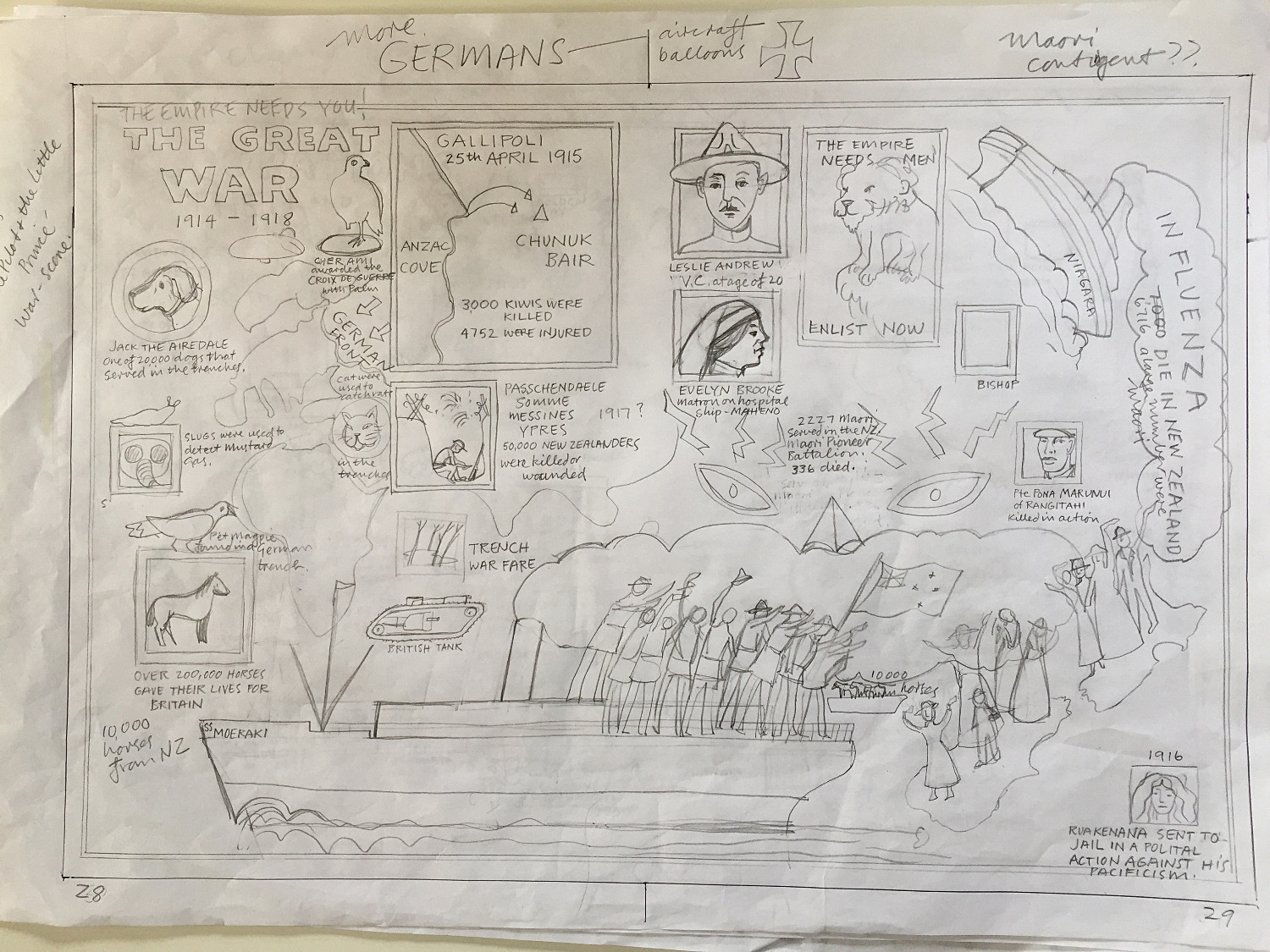
Like many illustrators, Gavin prides himself on never missing a deadline. He chortles nervously, recalling the sleepless nights. ‘It kinda struck me like a sledgehammer. I thought, I can’t get this finished in a year!’ But finish it he did, and readers will be completely oblivious to the artistic struggles and complexities behind Gavin’s wonderful art.
I know myself, there are sometimes lovely unintentional bonuses from this pressure cooker kind of illustration schedule. I love the pages where Gavin has slipped New Zealand into a composition, on its side – literally showing kids their country from a new perspective.
Gavin doesn’t shy away from making us all take a good hard look in the mirror. Like the best children’s book creators, he doesn’t moralise either. Aotearoa presents the big issues: from Māori land confiscation, to our current immigration concerns, and even the lack of public toilets for tourists.
Gavin doesn’t shy away from making us all take a good hard look in the mirror. Like the best children’s book creators, he doesn’t moralise either.
‘There was no time for anyone to come forward and say ‘Hey, you should rethink that’, says Gavin. ‘There are some pretty edgy statements, which I’ve been allowed to get away with.’
But a historical work is never finished. Gavin and I chat about new findings since Aotearoa’s print deadline: Zealandia is now its own continent; and we laugh when Gavin tells me of a dinosaur expert met at the Marlborough Book Festival. ‘He told me the dinosaurs weren’t all wiped out by an asteroid. I said, ‘Oh bugger – I’ve just put that in my book’.’
Aotearoa is a history of us, right now, where we stand and just how far we’ve come. It’s a history which introduces our kids to important issues to look back on as they step into the future. Everyone should read Gavin Bishop’s Aotearoa with their kids. It’ll send them leaping off on their own voyages of discovery.
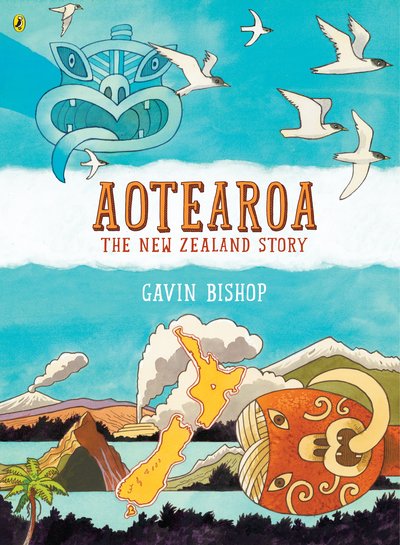
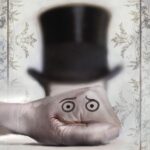
Donovan Bixley
Donovan Bixley was born in Perth, Australia, but shortly after, his family returned to New Zealand where Donovan grew up in the geothermal wilds of Taupo, where he continues to live. His work covers a broad range of genres from his best-selling pre-school books The Wheels on the Bus and Old MacDonald’s Farm, to his internationally acclaimed illustrated biographies Faithfully Mozart and Much Ado About Shakespeare which won the Russell Clark Award for best illustration at the 2016 NZ Book Awards for Children and Young Adults.
He has just released the fourth book in his Flying Furballs series, Most Wanted (Upstart Press), and has also published The Christmas Looky Book (Hachette NZ) this month.



